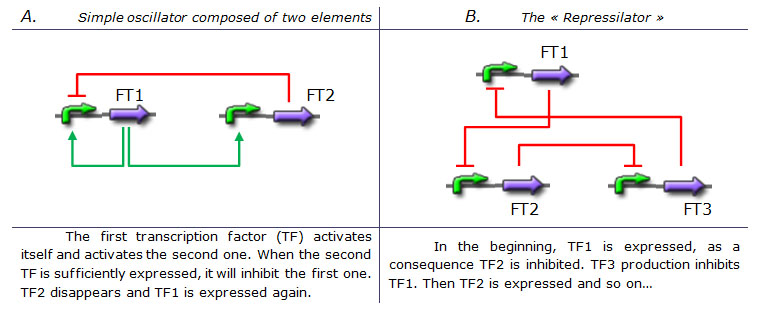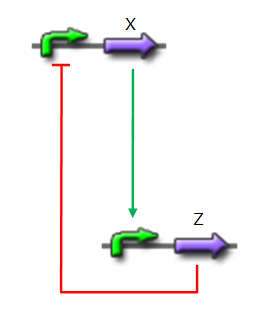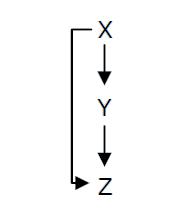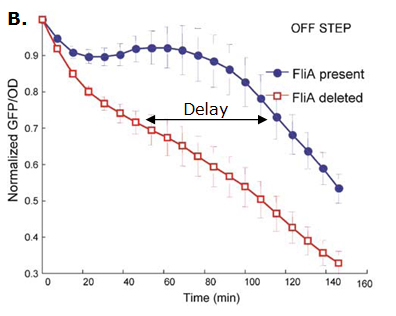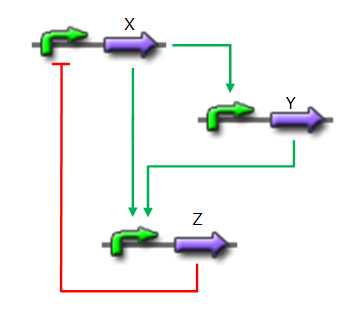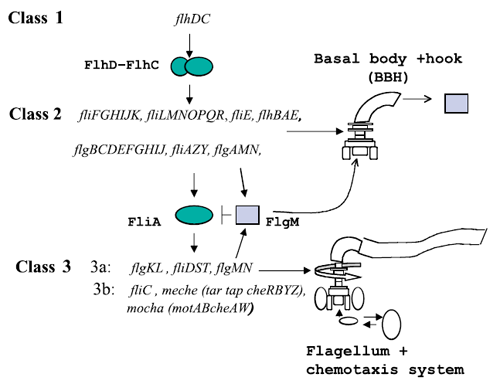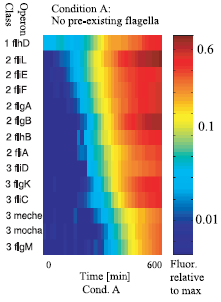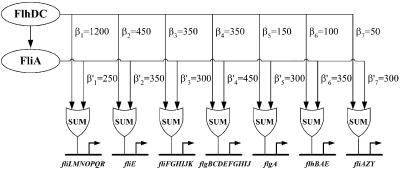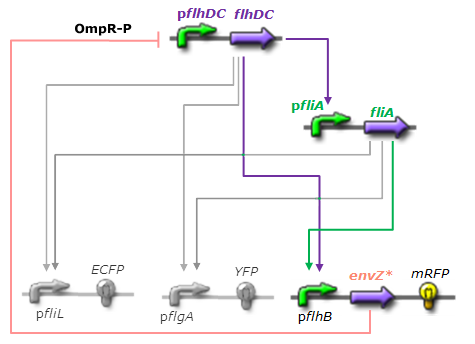Team:Paris/Analysis/Design2
From 2008.igem.org
(→Implementation of the core system) |
m (Team:Paris/Network Design2 moved to Team:Paris/Analysis/Design2) |
||
| (11 intermediate revisions not shown) | |||
| Line 1: | Line 1: | ||
{{Paris/Menu}} | {{Paris/Menu}} | ||
{{Paris/Header|Network Design - Part 2}} | {{Paris/Header|Network Design - Part 2}} | ||
| + | {{Paris/Section_contents_project}} | ||
=Creating an oscillating system= | =Creating an oscillating system= | ||
| Line 23: | Line 24: | ||
[http://www.ncbi.nlm.nih.gov/pubmed/16729041?ordinalpos=1&itool=EntrezSystem2.PEntrez.Pubmed.Pubmed_ResultsPanel.Pubmed_DefaultReportPanel.Pubmed_RVDocSum Shiraz Kalir ''et al.'' (2004)] studied the complex network of gene that lead to the synthesis of ''E. coli'' flagella. | [http://www.ncbi.nlm.nih.gov/pubmed/16729041?ordinalpos=1&itool=EntrezSystem2.PEntrez.Pubmed.Pubmed_ResultsPanel.Pubmed_DefaultReportPanel.Pubmed_RVDocSum Shiraz Kalir ''et al.'' (2004)] studied the complex network of gene that lead to the synthesis of ''E. coli'' flagella. | ||
A C1-FFL is present in this network. | A C1-FFL is present in this network. | ||
| + | {{Paris/Toggle|Click here to know more about ''E. coli'' flagella.|Team:Paris/Flagella}} | ||
*X is flhDC, the master regulator of the synthesis of the flagella. It is associated to its natural promoter. | *X is flhDC, the master regulator of the synthesis of the flagella. It is associated to its natural promoter. | ||
*Y is fliA, another transcription factor that regulates the expression of a large amount of flagellar genes. fliA is also associated with its natural promoter. | *Y is fliA, another transcription factor that regulates the expression of a large amount of flagellar genes. fliA is also associated with its natural promoter. | ||
| Line 29: | Line 31: | ||
== Limits of our network == | == Limits of our network == | ||
| - | Intuitively, it seems that there is a range of parameters that | + | Intuitively, it seems that there is a range of parameters that permits oscillations. However, [[Team:Paris/Network_analysis_and_design/Core_system#Oscillations|an analysis]] of the core system highlighted the fact that it could hardly have an oscillating dynamics ([[Team:Paris/Network_analysis_and_design/Core_system#Oscillations|see figure: Simulation of the core system]]). |
| - | Among the [[Team:Paris/Network_analysis_and_design/Core_system#System_Improvements|alternatives]] we studied, the system that could most probably oscillate is | + | Among the [[Team:Paris/Network_analysis_and_design/Core_system#System_Improvements|alternatives]] we studied, the system that could most probably oscillate is a [[Team:Paris/Network_analysis_and_design/System_improvements/Analysis#HSL mediated simple oscillator|HSL mediated simple oscillator]] that uses the quorum sensing to produce both a delay and the synchronization at the population level. |
| - | + | {{Paris/Navig|Team:Paris/Project}} | |
Latest revision as of 06:55, 30 October 2008
|
Network Design - Part 2
Creating an oscillating systemAlready existing genetic oscillators and their limitsDesigning a simple genetic network that presents an oscillatory behavior is one of the first challenge synthetic biology overcame. More or less successfully. We can count more than ten synthetic genetic oscillators that have varied period and mechanisms. [http://www.ncbi.nlm.nih.gov/pubmed/16604190?ordinalpos=2&itool=EntrezSystem2.PEntrez.Pubmed.Pubmed_ResultsPanel.Pubmed_DefaultReportPanel.Pubmed_RVDocSum Raúl GUANTES and Juan F. POYATOS (2006)] studied the most simple oscillators composed of two elements while [http://www.ncbi.nlm.nih.gov/pubmed/10659856?ordinalpos=10&itool=EntrezSystem2.PEntrez.Pubmed.Pubmed_ResultsPanel.Pubmed_DefaultReportPanel.Pubmed_RVDocSum Michael B. ELOWITZ and Stanislas LEIBLER (2000)] designed the more complex "repressilator" (Table 1), to quote only the best known. Both oscillators work : we can observe oscillations but only a limited number of cycles. Actually, they always reach a steady-state because the degradation/dilution rate is often too low : at the end of each cycle, the conditions are not exactly the initial conditions. Experimentally, the longer is the period the more cycles we can observe. Design of our genetic oscillator : The Feed Forward LoopWe want to design a simple oscillator that oscillates during as many cycles as possible. We propose a system based on an oscillator composed of two elements (Network 1) on which we added a delay at the end of each cycle. Uri ALON described genetic network motifs that generate a delay. Those motifs are the type 1 coherent Feed Forward Loop (C1-FFL). ↓ More on Feed Forward Loop ↑
We will use one of those network to increase the run of each period and permit more oscillations (Network 2). Implementation of the core system[http://www.ncbi.nlm.nih.gov/pubmed/16729041?ordinalpos=1&itool=EntrezSystem2.PEntrez.Pubmed.Pubmed_ResultsPanel.Pubmed_DefaultReportPanel.Pubmed_RVDocSum Shiraz Kalir et al. (2004)] studied the complex network of gene that lead to the synthesis of E. coli flagella. A C1-FFL is present in this network. ↓ Click here to know more about E. coli flagella. ↑
Limits of our networkIntuitively, it seems that there is a range of parameters that permits oscillations. However, an analysis of the core system highlighted the fact that it could hardly have an oscillating dynamics (see figure: Simulation of the core system). Among the alternatives we studied, the system that could most probably oscillate is a HSL mediated simple oscillator that uses the quorum sensing to produce both a delay and the synchronization at the population level.
|
 "
"

